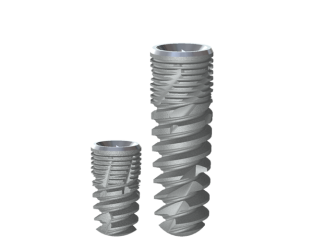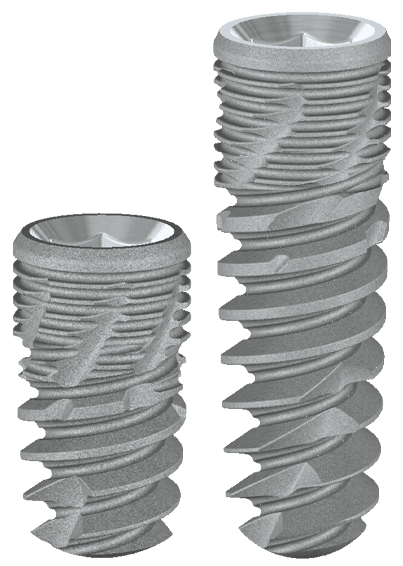Dental implants: what you should know
This is a complete guide to dental implants. We will outline the benefits and importance of dental implants and how the procedure itself works. Also, we will cover which type of dental practitioner would best fit your needs and the types of questions you may want to ask them so you can feel secure that you are making the best decisions to enjoy a healthy and happy smile for years to come.
Dental implants: what you should know
This is a complete guide to dental implants. We will outline the benefits and importance of dental implants and how the procedure itself works. Also, we will cover which type of dental practitioner would best fit your needs and the types of questions you may want to ask them so you can feel secure that you are making the best decisions to enjoy a healthy and happy smile for years to come.
Dental implants: what you should know
This is a complete guide to dental implants. We will outline the benefits and importance of dental implants and how the procedure itself works. Also, we will cover which type of dental practitioner would best fit your needs and the types of questions you may want to ask them so you can feel secure that you are making the best decisions to enjoy a healthy and happy smile for years to come.
What causes tooth loss?
Tooth loss is caused by a wide range of factors such as trauma, aging, or underlying genetic or medical conditions. The most common causes of tooth loss seen in the clinic today are periodontal disease and tooth decay. Due to the high incidence of gum disease and untreated tooth decay in adults >65 years old, about one-third of adults in the US are missing at least one tooth (CDC). There are extensive implications for tooth loss, mainly because it is directly associated with reduced chewing ability, leading to altered and limited food intake. In addition to nutritional status, tooth loss affects speech and physical appearance, both of which can have negative social impacts. Recently, researchers have linked tooth loss with cognitive impairment and other chronic medical conditions, yet more work needs to done.
What is a dental implant?
Dental implants are the primary choice of rehabilitation for tooth loss. A single implant is a structure inserted into the jawbone that mimics the natural root of the tooth. High quality implants are made of biocompatible titanium. The jawbone accepts this material, and the implant integrates into the bone and grows bone around it. Termed osseointegration, this process allows for stabilization.
The implant structure supports an artificial, custom-shaped crown that functions like a natural crown. As a unit, the dental implant and crown function effectively as a natural tooth, esthetically and mechanically. And just like with natural teeth, implants require maintenance of health and oral hygiene in order to last a very long time.
There are a wide variety of implant configurations geared towards an individual’s specific needs (i.e missing one, multiple, or all teeth, and soft or hard tissue issues).

What is a dental implant?
Dental implants are the primary choice of rehabilitation for tooth loss. A single implant is a structure inserted into the jawbone that mimics the natural root of the tooth. High quality implants are made of biocompatible titanium. The jawbone accepts this material, and the implant integrates into the bone and grows bone around it. Termed osseointegration, this process allows for stabilization.

The implant structure supports an artificial, custom-shaped crown that functions like a natural crown. As a unit, the dental implant and crown function effectively as a natural tooth, esthetically and mechanically. And just like with natural teeth, implants require maintenance of health and oral hygiene in order to last a very long time.
There are a wide variety of implant configurations geared towards an individual’s specific needs (i.e missing one, multiple, or all teeth, and soft or hard tissue issues).
Why are dental implants important?
Dental implants are important to maintain the quality of life that natural teeth provide. While these are actions that some take for granted, the ability to chew properly, speak correctly, eat nutritious food, and even smile fill us with confidence, security, and better overall health.
Not only do implants preserve our health from the outside-in, they effect our internal physiology by preserving bone and reducing bone resorption.
The detrimental effects of tooth loss, such as atrophy and weakening of supporting bone and comprised health of gum tissue, can be countered by implementing dental implants.
The protective role of implants is crucial, as over time, the damaging effects of tooth loss accumulate. By mimicking the natural function of the tooth, implants provide for chewing pressure and prevent jawbone atrophy, deterioration of bone density, and even potential disfigurement of the jawbone.
Implants preserve the health, strength, and shape of the jaw by simulating the natural mechanics of teeth, allowing for a better condition and appearance of the jawbone.
The Versatile Implant
The combination of innovative surface technology with 344% stronger bone reduces marginal bone loss and provides for a higher BIC%, decreasing the risk of peri-implant disease.
The enhanced deep thread simplifies the insertion and allows for high primary stability.

The Versatile Implant
The combination of innovative surface technology with 344% stronger bone reduces marginal bone loss and provides for a higher BIC%, decreasing the risk of peri-implant disease.
The enhanced deep thread simplifies the insertion and
allows for high primary stability.

What can you expect from an implant procedure?
Consultation and treatment plan
Practitioners will most likely perform a dental CT or panoramic X-ray to determine the condition of your gum and bone. Depending on this, you may require a bone graft (additional bone) before implantation.
Implant placement
The implant is placed relatively quickly into the jawbone under local anesthesia.
Healing and Osseointegration
The gums and mouth usually require about six months to heal, during which the implant integrates into the bone.
“Uncovering” the implant
The practitioner takes an impression of the implant location, which
a lab uses to make a custom
crown specific to your dental anatomy. The abutment and
crown are then secured to the implant.
What can you expect from an implant procedure?
Consultation and treatment plan
Practitioners will most likely perform a dental CT or panoramic X-ray to determine the condition of your gum and bone. Depending on this, you may require a bone graft (additional bone) before implantation.
Implant placement
The implant is placed relatively quickly into the jawbone
under local anesthesia.
Healing and Osseointegration
The gums and mouth usually require about six months to heal, during which the implant integrates into the bone.
“Uncovering” the implant
The practitioner takes an impression of the implant location, which a lab uses to make a custom crown specific to your dental anatomy. The abutment and crown are then secured to the implant.
What can you expect from an implant procedure?
Consultation and treatment plan
Practitioners will most likely perform a dental CT or panoramic X-ray to determine the condition of your gum and bone. Depending on this, you may require a bone graft (additional bone) before implantation.
Implant placement
The implant is placed relatively quickly into the jawbone under local anesthesia.
Healing and Osseointegration
The gums and mouth usually require about six months to heal, during which the implant integrates into the bone.
“Uncovering” the implant
The practitioner takes an impression of the implant location, which a lab uses to make a custom crown specific to your dental anatomy. The abutment and crown are then secured to the implant.
Immediate loading of dental implants
A new generation of implant procedures enables the placement of implant posts and a temporary prosthesis (crown) on the same day, termed immediate loading. The technological advances enable more accurate implant placement, reducing trauma and healing time. This procedure is particularly advantageous if the missing tooth is located at the front of the mouth.
While timesaving, immediate load implants require ample jaw and bone health. Ask your practitioner if this procedure is right for you.
The Highest Standard of Quality
At Dentalis Bio Solution, the safety and satisfaction of the patient is our top priority. We devote significant resources to ensure the design and manufacturing of our dental products is optimal. Quality and consistency are carefully monitored during the manufacturing process, and we employ stringent protocols in all facilities.
We follow the highest international standards for manufacturing and quality. All of our products are FDA approved, and our strict quality assurance adheres FDA standards (QSR 21 CFR 820). Our facilities undergo routine inspections by certified international inspectors. Our clean room maintains the cleanliness specifications of level 100 for manufacturing.

Choosing Your Implantologist
Choosing the right dental expert is a critical part of the process. While sophisticated, the procedure for dental implants has health and financial implications and can take weeks or months to complete. Therefore, your rapport and comfort level with the dentist should be a priority wherein communication is encouraged.
You should feel at ease in asking questions, and above all, your practitioner should be transparent with you. Ensure that your dentist is using the best quality implants and biomaterials to offer you optimal results.
Dentalis Bio Solution works with practitioners to provide their patients with a wide variety of long-lasting and innovative dental implants
What to expect during recovery and the restorative procedure?
Instructions for the first 24 hours
- No smoking. Smoking is a well-known risk factor, as it impairs healing and can cause a bone graft to fail
- Avoid chewing and eating in the area, particularly hot and hard foods
- Cold and soft foods such as ice cream and yogurt are recommended
- Refrain from rigorous physical activity
- Follow all additional instructions provided by your doctor
Instructions after the first 24 hours
- Avoid aggressive tooth brushing, it must be done gently in the area, especially in the case of a bone graft.
- No smoking
- Continue eating cold and soft foods, and avoid hard foods.
- Take all medications as directed, especially the antibiotic regimen to prevent infection
- If you experience persistent swelling, or any unusual sign, such as inflammation or fever, contact your doctor as soon as possible.

What to expect during recovery and the restorative procedure?
Instructions for the first 24 hours
- No smoking. Smoking is a well-known risk factor, as it impairs healing and can cause a bone graft to fail
- Avoid chewing and eating in the area, particularly hot and hard foods
- Cold and soft foods such as ice cream and yogurt are recommended
- Refrain from rigorous physical activity
- Follow all additional instructions provided by your doctor

Instructions after the first 24 hours
- Avoid aggressive tooth brushing, it must be done gently in the area, especially in the case of a bone graft.
- No smoking
- Continue eating cold and soft foods, and avoid hard foods.
- Take all medications as directed, especially the antibiotic regimen to prevent infection
- If you experience persistent swelling, or any unusual sign, such as inflammation or fever, contact your doctor as soon as possible.
Possible risks and complications
Speak with your dentist on how to maintain and care for your implants in order to minimize infection. If you experience signs of an infection, speak with your doctor as soon as possible to develop a treatment plan.
Gum tissue may recede around the implants
Nerve or tissue damage may occur. Implant placement close to a nerve may affect its sensitivity, leading to pain or an abnormal sensation that could last for a long time in the implant area or the surrounding tissue, such as the gums or skin.

Possible risks and complications
Speak with your dentist on how to maintain and care for your implants in order to minimize infection. If you experience signs of an infection, speak with your doctor as soon as possible to develop a treatment plan.
Gum tissue may recede around the implants
Nerve or tissue damage may occur. Implant placement close to a nerve may affect its sensitivity, leading to pain or an abnormal sensation that could last for a long time in the implant area or the surrounding tissue, such as the gums or skin.

Pain following placement of dental implants
As with most surgeries, dental implant surgery may result in pain or extreme discomfort in the affected area.
Patients may experience swelling, bruising, inflammation, and in some cases, slight bleeding, in the treatment area during the first few days of recovery.
These indications are to be expected. Be sure to follow the post-op instructions provided by your dentist to optimize your recovery.
Healing time varies on an individual basis
Typically the healing process lasts for two to six months, during which the implant is integrating into the jawbone to facilitate stabilization and strength.
Be sure to avoid exerting unnecessary force on the treatment area, taking care to avoid hard foods.
Expect a follow-up after your implant surgery. You practitioner will assess the area to ensure there is no infection and healing is going as planned.
If the area has healed properly, the dentist will continue the implant procedure by adding a customized restorative abutment.
What happens if the implant fails?
There is a small possibility that the implant will not integrate successfully with the jawbone, and therefore must be removed. Your practitioner will advise you on the next steps.
Expect a follow-up after your implant surgery. You practitioner will assess the area to ensure there is no infection and healing is going as planned.
If the area has healed properly, the dentist will continue the implant procedure
These indications are to be expected. Be sure to follow the post-op instructions provided by your dentist to optimize your recovery.
Pain following placement of dental implants
As with most surgeries, dental implant surgery may result in pain or extreme discomfort in the affected area.
Patients may experience swelling, bruising, inflammation, and in some cases, slight bleeding, in the treatment area during the first few days of recovery.
These indications are to be expected. Be sure to follow the post-op instructions provided by your dentist to optimize your recovery.
Healing time varies on an individual basis
Typically the healing process lasts for two to six months, during which the implant is integrating into the jawbone to facilitate stabilization and strength.
Be sure to avoid exerting unnecessary force on the treatment area, taking care to avoid hard foods.
Expect a follow-up after your implant surgery. You practitioner will assess the area to ensure there is no infection and healing is going as planned.
If the area has healed properly, the dentist will continue the implant procedure by adding a customized restorative abutment.
What happens if the implant fails?
There is a small possibility that the implant will not integrate successfully with the jawbone, and therefore must be removed. Your practitioner will advise you on the next steps.
Expect a follow-up after your implant surgery. You practitioner will assess the area to ensure there is no infection and healing is going as planned.
If the area has healed properly, the dentist will continue the implant procedure
These indications are to be expected. Be sure to follow the post-op instructions provided by your dentist to optimize your recovery.
FAQ
Implants are highly successful, convenient, and long-lasting. Maintenance is the same as natural teeth, so patients feel more confident caring for them.
Stay Safe. Wear a Mask!
The combination of innovative surface technology with 344% stronger bone reduces marginal bone loss and provides for a higher BIC%, decreasing the risk of peri-implant disease. The enhanced
deep thread simplifies the insertion and allows
for high primary stability.
The combination of innovative surface technology with 344% stronger bone reduces marginal bone loss and provides for a higher BIC%, decreasing the risk of peri-implant disease. The enhanced deep thread simplifies the insertion and allows
for high primary stability.
The combination of innovative surface technology with 344% stronger bone reduces marginal bone loss and provides for a higher BIC%, decreasing the risk of peri-implant disease. The enhanced
deep thread simplifies the insertion and allows
for high primary stability
